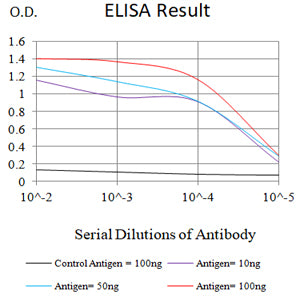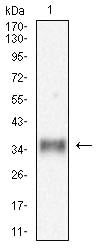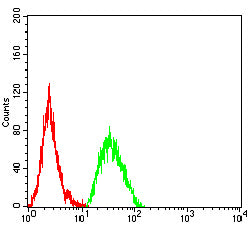


| WB | 1/500 - 1/2000 | Human,Mouse,Rat |
| IF | 咨询技术 | Human,Mouse,Rat |
| IHC | 咨询技术 | Human,Mouse,Rat |
| ICC | 技术咨询 | Human,Mouse,Rat |
| FCM | 1/200 - 1/400 | Human,Mouse,Rat |
| Elisa | 1/10000 | Human,Mouse,Rat |
| Aliases | MDL1; MDL-1; CLECSF5 |
| Entrez GeneID | 23601 |
| clone | 1B5G12 |
| WB Predicted band size | 21.5kDa |
| Host/Isotype | Mouse IgG1 |
| Antibody Type | Primary antibody |
| Storage | Store at 4°C short term. Aliquot and store at -20°C long term. Avoid freeze/thaw cycles. |
| Species Reactivity | Human |
| Immunogen | Purified recombinant fragment of human CLEC5A (AA: extra(28-188)) expressed in E. Coli. |
| Formulation | Purified antibody in PBS with 0.05% sodium azide |
+ +
以下是关于CLEC5A抗体的3篇代表性文献及其摘要:
1. **文献名称**:*CLEC5A is a critical receptor in innate immunity against Listeria infection*
**作者**:Chen et al.
**摘要**:该研究发现CLEC5A在识别单核细胞增生李斯特菌中起关键作用,使用抗CLEC5A单克隆抗体阻断受体后,显著抑制了巨噬细胞的炎症反应,降低了细菌感染引起的全身性炎症损伤。
2. **文献名称**:*Anti-CLEC5A antibody therapy suppresses inflammatory responses and attenuates disease severity in dengue virus infection*
**作者**:Wu et al.
**摘要**:研究证明,CLEC5A与登革病毒激活的炎症风暴密切相关。通过开发靶向CLEC5A的中和抗体,在小鼠模型中有效抑制了细胞因子释放,减轻了病毒引起的血管渗漏和器官损伤。
3. **文献名称**:*Targeting CLEC5A in tumor-associated macrophages for cancer immunotherapy*
**作者**:Huang et al.
**摘要**:该文献揭示了肿瘤微环境中CLEC5A高表达于肿瘤相关巨噬细胞(TAMs),并促进免疫抑制功能。使用抗CLEC5A抗体阻断信号通路后,TAMs的抗肿瘤活性增强,显著抑制了小鼠模型中肿瘤的生长和转移。
4. **文献名称**:*CLEC5A regulates synovial inflammation and bone erosion in rheumatoid arthritis*
**作者**:Lee et al.
**摘要**:研究表明,CLEC5A在类风湿性关节炎患者的滑膜组织中高表达,介导促炎细胞因子释放。抗CLEC5A抗体治疗减少了小鼠关节炎模型的关节肿胀和骨质破坏,提示其作为潜在治疗靶点。
以上文献均聚焦于CLEC5A抗体在调控炎症或免疫应答中的机制及治疗潜力,涵盖感染、自身免疫病和肿瘤等领域。
CLEC5A (C-type lectin domain family 5 member A), also known as MDL-1. is a pattern recognition receptor (PRR) belonging to the C-type lectin family. It is primarily expressed on myeloid cells, including macrophages, neutrophils, and dendritic cells. CLEC5A recognizes pathogen-associated molecular patterns (PAMPs) from viruses, bacteria, and fungi, such as dengue virus, *Staphylococcus aureus*, and *Aspergillus fumigatus*. Upon ligand binding, CLEC5A associates with the adaptor protein DAP12 to activate downstream signaling pathways, including Syk kinase, leading to the production of pro-inflammatory cytokines (e.g., TNF-α, IL-6) and reactive oxygen species. While this response is critical for host defense, excessive CLEC5A activation can exacerbate inflammatory diseases, sepsis, or viral-induced cytokine storms.
CLEC5A-targeting antibodies have emerged as therapeutic tools to modulate immune responses. Antagonistic antibodies blocking CLEC5A-DAP12 interactions have shown potential in preclinical models to mitigate hyperinflammation in dengue infection, rheumatoid arthritis, and septic shock. Conversely, agonist antibodies may enhance pathogen clearance in immunocompromised conditions. Challenges remain in balancing efficacy and safety, as CLEC5A also plays roles in tissue homeostasis and cross-talk with other PRRs (e.g., TLRs). Current research focuses on optimizing antibody specificity and exploring combination therapies to harness CLEC5A's dual role in immunity and inflammation.
×